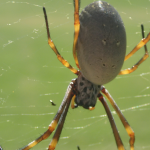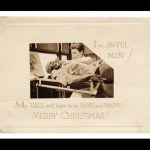body
A new study from researchers at the University of Sydney shows that golden orb-weaving spiders (Nephila plumipes) that live in the city are larger and produce more offspring as compared to country living.
When they say the spiders are big, they mean really big. The females can reach up to 20-25mm (males are only ~5mm).
Image from Spiders of Australia http://ednieuw.home.xs4all.nl/australian/nephila/Nephila.html
The researchers speculate that the urban heat island effect, which is attributed to a lack vegetation and hard surfaces, may lead to the increased body size as invertebrates in…
The trailer for Shaun of the Dead.
Not all zombies are created equal. The most popular zombie archetype is a shambling, brain-eating member of the recently deceased, but, in recent films from 28 Days Later to Zombieland, the definition of what a zombie is or isn't has become more complicated. Does a zombie have to be a cannibal corpse, or can a zombie be someone infected with a virus which turns them into a blood-crazed, fast-running monster?
For my own part, I have always preferred the classic George Romero zombies from the original Dawn of the Dead and Day of the Dead films (as well as…
In 1926 German illustrator Fritz Kahn drew Der Mensch als Industriepalast, part of a series of artworks reinterpreting the body as a mechanical factory. Now fellow countryman and artist Henning Lederer has updated the the famous image, turning it into an interactive animation.
He says:
The visual crossover between industrialization and science in Fritz Kahn's artwork demonstrates surprisingly accurately how human nature became culturally encoded by placing the knowledge in an industrial modernity of machine analogues. He produced lots of illustrations that drew a direct functional analogy…
Christmas greeting card, school unknown, circa 1920.
Dittrick Medical History Center
from Dissection: Photographs of a Rite of Passage in American Medicine 1880-1930
Slate has an intriguing new review by Barron Lerner of a book called Dissection: Photographs of a Rite of Passage in American Medicine 1880-1930, by John Harley Warner and James M. Edmonson. The book delves into the turn-of-the-century practice of photographing medical students with cadavers - photos that today read as weird, grotesque, even offensive.
The photos unearthed by Warner and Edmonson depict an astonishing variety of…
Last week, scientists positively identified the bones of Nicolaus Copernicus, the astronomer credited with scientifically formulating the idea that the universe is heliocentric and prompting the 16th century scientific revolution. To be sure that the bones were actually those of Copernicus, the scientists compared DNA from the unmarked remains found in a grave beneath Frombork Cathedral with DNA collected from the pages of one of Copernicus' books and found them to be identical. Using computer modeling software, his face has been virtually reconstructed.

